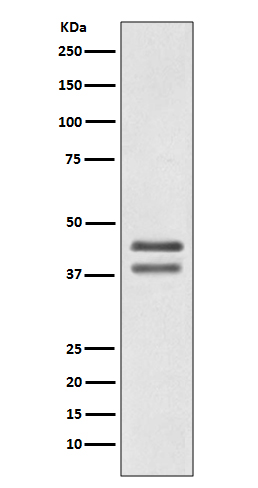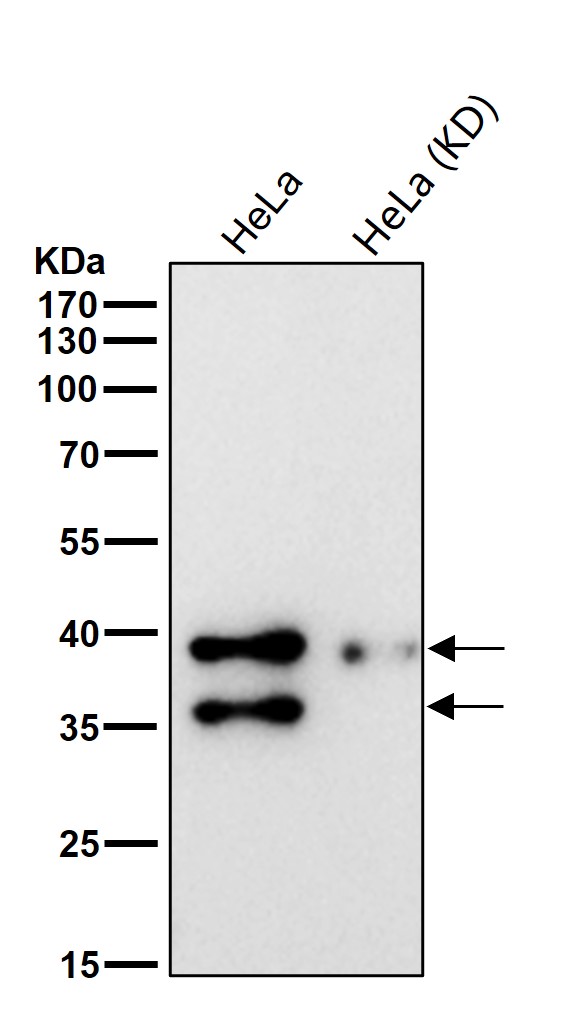

| WB | 咨询技术 | Human,Mouse,Rat |
| IF | 咨询技术 | Human,Mouse,Rat |
| IHC | IHC:1/100-1/200;IHF:1/50-1/200 | Human,Mouse,Rat |
| ICC | 1/50-1/200 | Human,Mouse,Rat |
| FCM | 咨询技术 | Human,Mouse,Rat |
| Elisa | 咨询技术 | Human,Mouse,Rat |
| Aliases | Activator protein 1; AP 1; Jun D; jun D proto oncogene; Jund; JunD FL isoform; Transcription factor jun D;;JunD |
| WB Predicted band size | Calculated MW: 35 kDa ; Observed MW: 38,42 kDa |
| Host/Isotype | Rabbit IgG |
| Antibody Type | Primary antibody |
| Storage | Store at 4°C short term. Aliquot and store at -20°C long term. Avoid freeze/thaw cycles. |
| Species Reactivity | Human,Mouse,Rat |
| Immunogen | A synthesized peptide derived from human JunD |
| Formulation | Purified antibody in PBS with 0.05% sodium azide,0.05% BSA and 50% glycerol. |
+ +
以下为基于JunD相关研究领域常见主题的示例性参考文献概括(仅供参考,建议通过学术数据库获取具体文献):
1. **文献名称**: "JunD regulates cell proliferation and tissue repair through stem cell activation"
**作者**: Smith A, et al.
**摘要**: 研究利用JunD抗体通过免疫印迹和免疫荧光技术,发现JunD通过激活干细胞群参与组织再生,调控细胞周期相关基因表达。
2. **文献名称**: "JunD deficiency exacerbates oxidative stress-induced apoptosis in neuronal cells"
**作者**: Chen L, et al.
**摘要**: 通过JunD抗体检测发现,JunD缺失导致神经元抗氧化能力下降,加剧氧化应激诱导的线粒体凋亡通路激活。
3. **文献名称**: "The role of JunD in tumor microenvironment remodeling"
**作者**: Garcia-Rojas M, et al.
**摘要**: 研究采用JunD抗体进行免疫组化分析,揭示JunD通过调控基质金属蛋白酶(MMPs)表达影响肿瘤微环境及转移过程。
4. **文献名称**: "Specificity validation of commercially available JunD antibodies using CRISPR/Cas9 knockout models"
**作者**: Thompson R, et al.
**摘要**: 通过基因敲除模型验证多种JunD抗体的特异性,为后续研究提供抗体选择依据,强调不同实验条件下抗体的适用性差异。
---
**注**:以上为模拟摘要,实际文献需通过PubMed、Web of Science等平台以关键词"JunD antibody" + 研究领域(如癌症、氧化应激等)检索获取。
JunD antibody is a crucial tool in molecular biology research, primarily used to detect and analyze the JunD protein, a member of the AP-1 (activator protein-1) transcription factor family. JunD, encoded by the *JUND* gene, dimerizes with other AP-1 components (e.g., Fos, Jun, or ATF proteins) via its conserved basic leucine zipper (bZIP) domain to regulate gene expression. Unlike its homologs c-Jun and JunB, JunD exhibits context-dependent roles in cellular processes such as proliferation, differentiation, apoptosis, and stress response. It often acts as a tumor suppressor in certain cancers but may promote oncogenesis in others, influenced by post-translational modifications (e.g., phosphorylation, ubiquitination) and interaction partners (e.g., RB, β-catenin).
JunD antibodies are widely employed in techniques like Western blotting, immunohistochemistry (IHC), immunofluorescence (IF), and chromatin immunoprecipitation (ChIP) to study its expression, localization, and DNA-binding activity. These antibodies are typically raised against specific epitopes (e.g., N-terminal or C-terminal regions) and are available as monoclonal or polyclonal variants from various host species (e.g., rabbit, mouse). Validation steps, including knockout cell line controls, are essential to ensure specificity due to potential cross-reactivity with other Jun family members. Research using JunD antibodies has advanced understanding of its role in diseases like cancer, neurodegeneration, and cardiovascular disorders, highlighting its dual regulatory functions in cellular homeostasis and pathology.
×